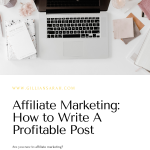
Affiliate Marketing: How to Write A Profitable Post
Table of Contents
ToggleSharing is caring!
Reading Time: 6 minutes



Are you new to affiliate marketing?
But you've heard it so many times, you're like, alright it must be good so you came to this post to learn more about it.
Maybe you've tried it out a few times on your blog here and there but you're really getting many sales and it just doesn't seem as magical as everyone makes it seem.
Look, if affiliate marketing was easy, everyone and their dog would be billionaires.
The key is using the right strategies.
I'll be sharing with you the best strategies and tips to get the most bang for your buck with affiliate marketing and breaking down how to actually write a money making blog post.
Before we take a deep dive into this post, I want to make sure you read this post to ensure you have all the fundaments of blogging down and have your blog correctly set up before learning about making money blogging.
disclaimer: this post contains affiliate links which means I make a small commission if you choose to use my link to purchase a product and if you do I appreciate you.
Affiliate Marketing Definition
The idea behind affiliate marketing is pretty simple.
You sign up to become an affiliate for a company, like Amazon, Target, or whoever and you promote their products through blog posts (what we're talking about today), Pinterest, youtube and/or social media.
When someone uses your link (given to you by the affiliate company) you make a commission.
Commissions range anywhere from a few cents to a few hundred dollars. It simply depends on the company.
Pretty much any company you can think of has an affiliate program.
The beauty of this is that the company you are “selling” for is doing the hard stuff for you.
You’re just telling your audience how much it helped you, how much you enjoyed it, whatever the case may be.
1. Figure Out Your Audience's Pain Points
Before you even start signing up for affiliate programs, you have to fully understand what your audience needs and what their pain points are.
Why?
Because the products you are recommending are going to be the solution your audience needs.
You're not just promoting products for the heck of it.
So, do you know your audience?
How to Find Your Audience's Pain Points:
- Ask them via email or social media (use a poll on Instagram)
- Get on Facebook groups in your niche and read through common comments and questions
- Use comments on your own blog or others in your niche and see which questions pop up often
- If all else fails, think about what problems you had pertaining to your niche and what products helped you solve those problems
2. Create a Blog Post Around a Single Problem
I understand the temptation might be there to create a blog post littered with affiliate links all over the place, because the more links you have, the more opportunities to make money right?
Wrong.
The point of your affiliate posts is to serve your audience and help them solve a problem.
If they have to sift through link after link just to find the one that pertains to their problem, they're just going to leave.
Which means you won't make a sale and more importantly, your user experience was compromised.
Instead, choose one problem you know your audience is facing.

As you can see above, all these individual posts are very clear about what problem they are going to solve and the solution is going to a specific product.
Write an in-depth post about a specific solution to that problem and include affiliate links to that solution.
Here are a few examples:
1. How to Apply Foundation for All Day Coverage (if you have this post, I NEED THIS)
2. How to use *insert product* to Meal Prep for the Week
3. How to Start a Profitable WordPress Blog from Scratch
4. How to Style a Wrap Dress in Winter
How-to posts do really well for this because they are indirectly asking your audience a question while giving them the solution with your title.
But you can also use other posts like list posts. Check out this blog post for the top 5 types of blog posts to use for affiliate marketing.
3. Avoid Offering Too Many Solutions for The Same Problem
This one is going to need a bit of explanation but this is usually only a problem when it comes to digital products more so than physical products.
If you are promoting a digital product as a solution to a problem your audience has like an online course try to only focus on that one course.
It can be extremely confusing to your audience if you are writing a post and then recommend a course on starting a mom blog and then two paragraphs later, you recommend a different course that solves that same problem.
They're not going to know which one to actually choose and thus, not purchase.
You also want to make sure you're building as much trust as possible so if you're recommending every single course out there it's going to come across as spammy and not as genuine.
If you've taken multiple courses for something you know your audience needs, pick the one that helped you the most and only promote that one.
4. Build Credibility & Trust
People buy from people they trust.
This means you need to writing posts that are highly valuable to your audience and give them a reason to trust you.
One of the easiest ways to show your audience that you know your stuff when it comes to the products you're recommending is by creating a video tutorial.
In this post, 12 Essential Tasks to Do in Your first 90 Days of Blogging, I talked about a hosting company I personally use but I also took it one step further and added a screen-shared video tutorial of me using this host to set up a blog.
(You can reference that blog post and video by clicking the link above or watching the video below)
If video isn't your thing (although I highly recommend it if you can) or doesn't work with your affiliate product, you can also share pictures of you using the product.
This is a really simple way to build up trust and show your audience who you are a bit.
You don't have to do this for every single post with affiliate links but try it out a few times as your audience gets to know you.
Another thing that you can do to build trust with your readers is to disclose affiliate links when you are using them. It shows your audience that you are transparent when you recommend them something.
5. Use A Call to Action
A call to action is just as it sounds, tell your audience what to do next.
Slapping down a few affiliate links doesn't mean they're going to click on them.
Tell them why they should click.
What makes this product better than all the rest?
You don't have to get all salesy, but use your own story with the product to let your audience know of the benefits or what it is they'll actually get when they click.
It can be as simple as, “click here for a free 30-day trial” or “click here to get these affordable everyday jeans”.
As far as where and how many links to add to your posts, here are a few suggestions:
- Don't go overboard with links, use common sense
- Use links in the beginning, middle, and end (people are skimming)
- Play around with the number of links and make them obvious (every niche will be different)
Promote Your Post
Following the tips I've laid out above will help you build a profitable affiliate post, but now you've got to share your post with the world.
Or at least, get it in front of your audience.
Drive traffic to your post via social media, search engines like Google and I'm just going to say it, Pinterest.
Use Pinterest.
If you don't know how to use Pinterest, read this.
Don't neglect your email list. Send your posts to your list and start generating social shares.
The point is, get your post out there.
Oh and pps. you can even use affiliate marketing on Pinterest. Don't worry, I've got a post for that, click here to read it.
Start Making Money Blogging
It is possible to make more than a few pennies from affiliate marketing, you just have to provide value and trust and your audience will buy using your links.
If you really want to step up your money making game, I highly recommend and stand behind this course <–click this link to check it out and/or sign up by Paul Scrivens.
It lays out the exact strategy you need to actually make money with affiliate marketing and goes much more in depth than I can in a blog post.
So if you want to make more money, check it out.
Did you find this helpful? Don't forget to share it with your friends!
Most Popular Posts:
Sharing is caring!
thanks for sharing this information.have shared this link with others keep posting such information..
Thank you, Carroll. I appreciate that.
Hi Emily,
Thanks for sharing this post. It’s been very helpful. I love using a call to actions especially if I want to give away freebies and templates.
Aaron
Thank you, Aaron, I’m so glad you found this post enjoyable and helpful!
I truly thank you with all my heart. This article helped me understand a lot about affiliate marketing, which I did not find in other articles.
thanks for clarifing about marketing blog post to us . its helpful to me . thank u for explaining